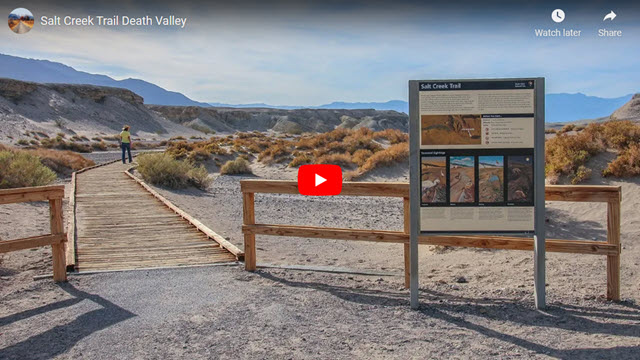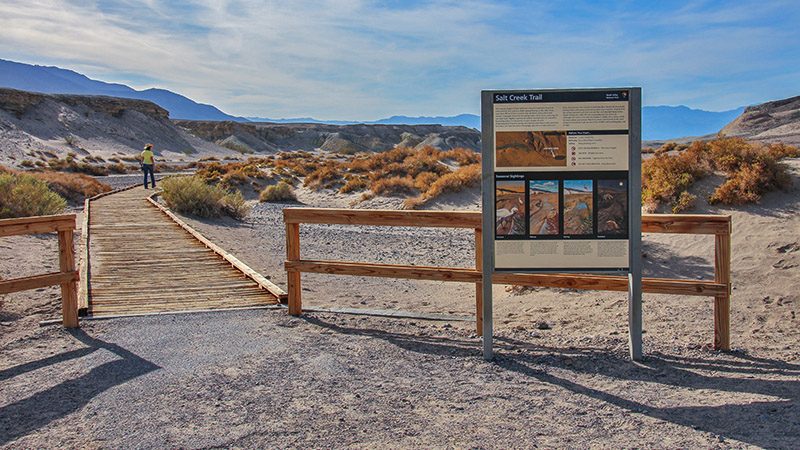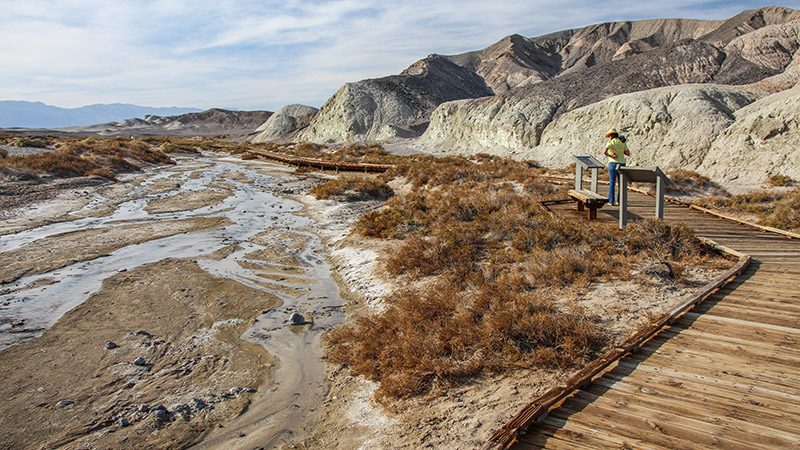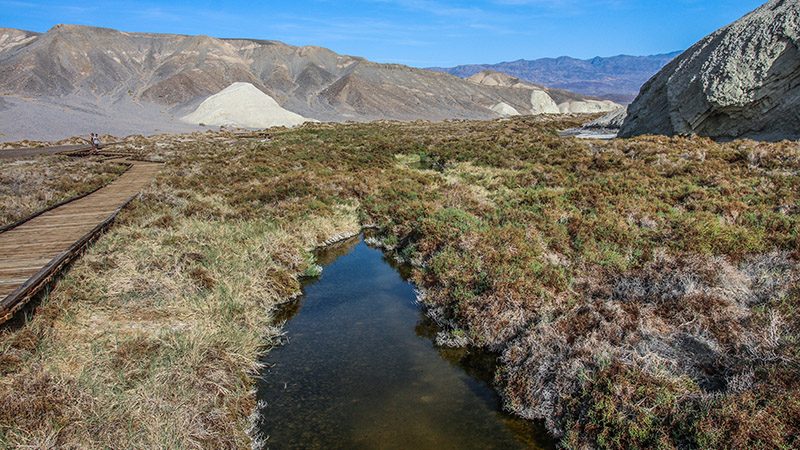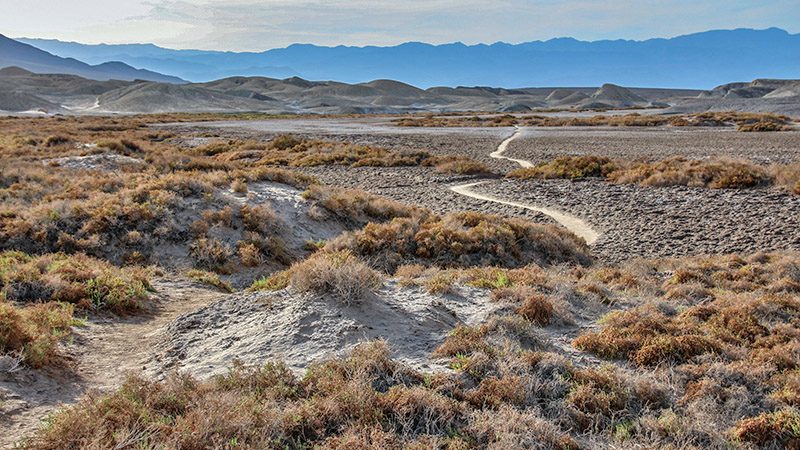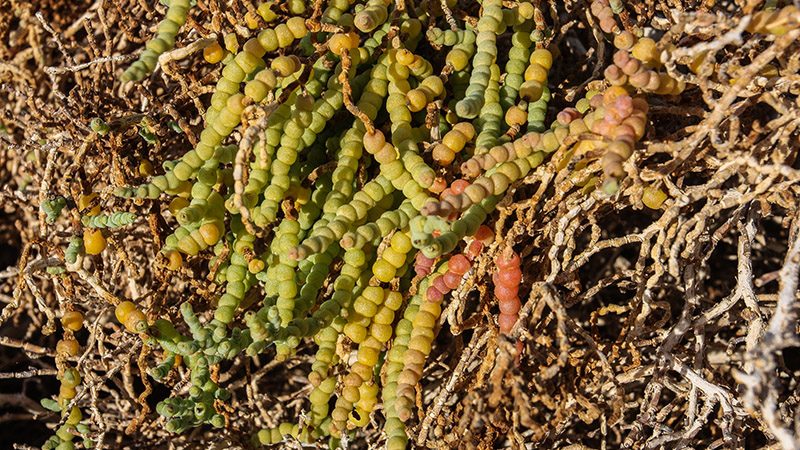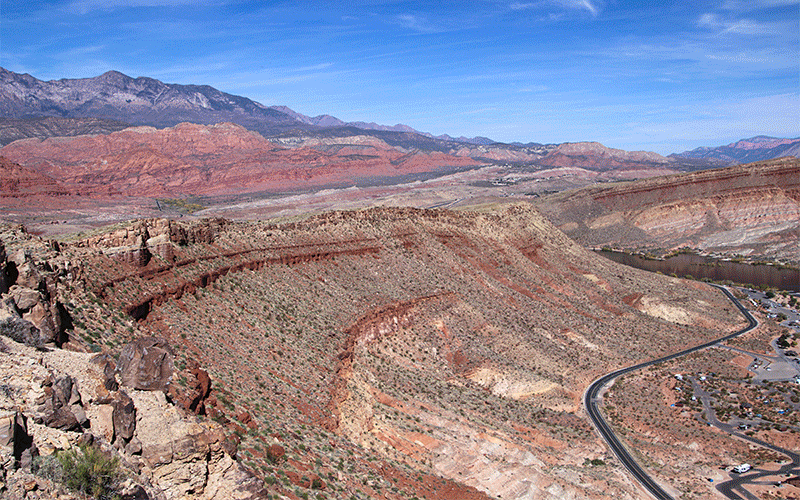Salt Creek Trail Death Valley
Located in the center of Death Valley, Salt Creek is a unique ecological area that is both caustic and sensitive. The caustic alkaline crust that covers everything here, coupled with the intense heat of Death Valley, would make anybody wonder how life can exist here and yet, it does. There are plants and even fish that tough it out in this salt marsh but, despite its tough-looking exterior, this ecosystem is fragile and easily damaged.
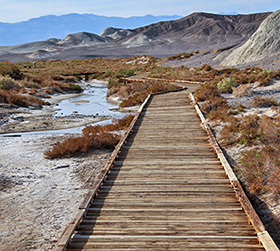
Thankfully, the Park Service has built a nice, long boardwalk here so that visitors can effortlessly observe this unique environment without disturbing it. Walking around in the alkaline mud would not only ruin the landscape and scar it for years to come but it would also ruin your shoes.
Briny Creek
The aptly named Salt Creek is a small, briny, meandering stream that drains portions of northern Death Valley. Just east of the parking area, its waters used to drain into a large, ancient inland lake known as Lake Manly that once filled most of Death Valley. The brininess of this creek (like other small streams and ponds found in Death Valley) comes from the large concentration of minerals that have been carried here from hundreds of miles away. At Salt Creek, these minerals have been deposited in this low valley for tens of thousands of years. These are not the clean and fresh waters you might find in other places in the desert.
Pupfish
One of the most surprising things about Salt Creek is that there are fish living in its waters. And there are lots of them. These pupfish, as they are called, are remnants of a broader species that used to occupy an ancient series of large inland lakes, such as Lake Manly, Lake Tecopa, Mono Lake (near Yosemite) and Owens Lake (near Lone Pine). Today, Mono Lake is the only one left.
Over the past 10-20 thousand years, the climate warmed, the ice age declined, glaciers melted and receded, and the lakes dried up. This process separated the pupfish and, over time, they evolved into their own different sub-species. These small holdouts of pupfish can be found today at different water holes stretching from Mono Lake to Death Valley. They can be different colors and have adapted in different ways to their own unique environments but they are all related to the one pupfish species from over 10,000 years ago.
Of all the small streams and ponds we’ve visited in this region looking for pupfish, Salt Creek has the largest population by far. The smallest population is in the mysterious Devils Hole, located in eastern Death Valley inside the Ash Meadows National Wildlife Refuge. Devils Hole has a particularly unique species of pupfish that has been isolated for a very long time. The small underwater “world” they live in is only about ten feet in diameter by about fifty feet deep and less than 200 of these fish survive today.
Why are they called pupfish? Well, the story goes that the first pioneers to encounter them were in route to the California gold fields. They unexpectedly found some small fish in the brackish, shallow streams that were wildly swimming around. They darted back and forth and in all directions. As the pioneers traveled on, they told the story of these strange fish that reminded them of playful puppy dogs and so the name was born.
In reality, the pupfish are swimming wildly because they are spawning. Just like in so many other settings in nature, the male fish are fighting off other males to garner the females. The pioneers passed by these waters in winter which is around the time when the pupfish were spawning (usually in February and March). If the pioneers had come by in July instead, who knows what name these little fish would have ended up with?
More…
Pictures
Below are some pictures of what you will see along the way.
Plants
The plants found at Salt Creek have had to adapt to the salt marsh environment. One common plant found here is a succulent called pickleweed. This odd-looking plant is comprised of many tube-like stems but no leaves. Like many other desert-dwelling plants, pickleweed does not grow leaves that are easily burned by the sun and consume too much water. It also has special cells that help it to emit excess salt. Another plant found here, saltgrass, deals with the excess salt by excreting it onto its surface to create glittering crystals that help to reflect the harmful rays of the sun. Both of these plants are specific to salt marsh areas.
Visiting
Salt Creek is an often overlooked place to visit in Death Valley which makes it a good place to go when all of the other, more popular spots are crowded. But beyond its more quiet nature, the best reason to go there is to see one of Death Valley’s most epic sagas…. how life survives. How it survives this harsh environment of searing heat in summer, freezing temperatures in winter and heavy mineralized soils and water to live in. It’s amazing how these plants and animals have adapted and a walk through Salt Creek will give you a close-up look of this adaptation in action. Don’t miss it!
Getting There
Getting to Salt Creek is easy. Look for the turn off from Death Valley’s main road, Hwy 190, at either 13 miles from Furnace Creek (the main Visitor’s Center) or 11 miles from Stovepipe Wells. Any type of vehicle can follow the mile-long dirt road to the trailhead parking area. Follow the easy, well-maintained boardwalk through the Salt Creek marsh and enjoy.
Trip Map
Support Us
Help us fill up our tank with gas for our next trip by donating $5 and we’ll bring you back more quality virtual tours of our trips!
Your credit card payment is safe and easy using PayPal. Click the [Donate] button to get started:
